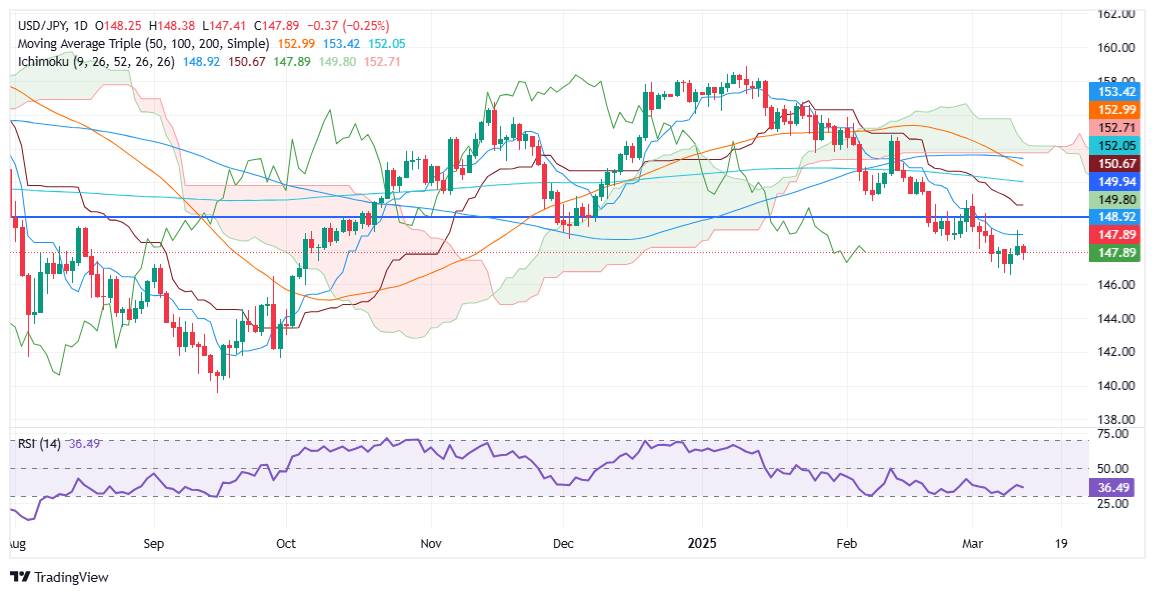- Analytics
- News and Tools
- Market News
- USD/JPY Price forecast: Struggles at 148.00, drops on risk aversion
USD/JPY Price forecast: Struggles at 148.00, drops on risk aversion
- USD/JPY starts Friday steady near 147.90 following Thursday’s 0.30% drop, pressured by unresolved US trade tensions.
- Pair fails to capitalize on recent bullish ‘tweezers bottom’ pattern near YTD lows, remaining vulnerable below key Tenkan-sen resistance.
- Break below immediate support at 146.54 could spark deeper selling; reclaiming 148.00 may pave way toward 149.79 resistance.
The USD/JPY begins Frida’s Asian session on a higher note, following Thursday’s losses of 0.305, that pushed the exchange rate to close at 147.81 daily. At the time of writing, the pair trades at 147.91, virtually unchanged, as traders continued to digest US President Donald Trump's tariff rhetoric.
USD/JPY Price Forecast: Technical outlook
Even though the USD/JPY formed a ‘tweezers bottom’ two candle chart pattern near the year-to-date (YTD) low of 146.54, two days ago, the pair failed to decisively clear the Tenkan-sen at 148.97, which opened the door for a retracement.
Consequently, the USD/JPY fell beneath 148.00 and continued to drop, aligned with the overall market. If the pair falls below the latter, the next support would be the March 11 swing low of 146.54.
Conversely, if USD/JPY climbs above 148.00 a rally towards testing the Senkou Span A at 149.79 is on the cards.
USDJPY Price Chart: Technical outlook

Japanese Yen FAQs
The Japanese Yen (JPY) is one of the world’s most traded currencies. Its value is broadly determined by the performance of the Japanese economy, but more specifically by the Bank of Japan’s policy, the differential between Japanese and US bond yields, or risk sentiment among traders, among other factors.
One of the Bank of Japan’s mandates is currency control, so its moves are key for the Yen. The BoJ has directly intervened in currency markets sometimes, generally to lower the value of the Yen, although it refrains from doing it often due to political concerns of its main trading partners. The BoJ ultra-loose monetary policy between 2013 and 2024 caused the Yen to depreciate against its main currency peers due to an increasing policy divergence between the Bank of Japan and other main central banks. More recently, the gradually unwinding of this ultra-loose policy has given some support to the Yen.
Over the last decade, the BoJ’s stance of sticking to ultra-loose monetary policy has led to a widening policy divergence with other central banks, particularly with the US Federal Reserve. This supported a widening of the differential between the 10-year US and Japanese bonds, which favored the US Dollar against the Japanese Yen. The BoJ decision in 2024 to gradually abandon the ultra-loose policy, coupled with interest-rate cuts in other major central banks, is narrowing this differential.
The Japanese Yen is often seen as a safe-haven investment. This means that in times of market stress, investors are more likely to put their money in the Japanese currency due to its supposed reliability and stability. Turbulent times are likely to strengthen the Yen’s value against other currencies seen as more risky to invest in.
© 2000-2025. All rights reserved.
This site is managed by Teletrade D.J. LLC 2351 LLC 2022 (Euro House, Richmond Hill Road, Kingstown, VC0100, St. Vincent and the Grenadines).
The information on this website is for informational purposes only and does not constitute any investment advice.
The company does not serve or provide services to customers who are residents of the US, Canada, Iran, The Democratic People's Republic of Korea, Yemen and FATF blacklisted countries.
Making transactions on financial markets with marginal financial instruments opens up wide possibilities and allows investors who are willing to take risks to earn high profits, carrying a potentially high risk of losses at the same time. Therefore you should responsibly approach the issue of choosing the appropriate investment strategy, taking the available resources into account, before starting trading.
Use of the information: full or partial use of materials from this website must always be referenced to TeleTrade as the source of information. Use of the materials on the Internet must be accompanied by a hyperlink to teletrade.org. Automatic import of materials and information from this website is prohibited.
Please contact our PR department if you have any questions or need assistance at pr@teletrade.global.















